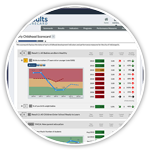A Recreation Entitlement
1. The Idea: One of the reasons so many kids get into trouble is because they have nothing better to do. Fly into an American city on a warm summer afternoon and count the baseball fields. Now count the fields with children on them – few, if any. Where are the children? Children need and deserve recreation programs that are safe, affordable and close to home. Recreation is one of the cheapest, and maybe most effective, broad based prevention programs we can provide. It builds self confidence and self esteem. It builds leadership skills and a sense of responsibility. And it can build what we now know to the an essential bond between a child and a caring adult. And, after years of cutbacks and years of no children’s policy and no urban policy, it seems to have disappeared from the urban, if not suburban and rural, landscape as a priority public service. It survives in the form of underfunded rec centers and fee-charging private leagues with seasons of short duration. What we need to do is to recreate recreation. We need some form of recreation entitlement for all children.
2. How it would work: One version of such a program could provide for 3 sport “seasons” (two of 8 week duration and one of 12 week duration) covering 28 weeks of the year:
Basketball Jan 15 to March 15 8 weeks
Baseball May 1 to July 31 12 weeks
Soccer or Football Sept 15 to Nov 15 8 weeks
Every child could participate free of charge. The program would use full time recreation counselors to oversee leagues of 200 children, using volunteer coaches who would receive stipends of $150 per season. Between seasons and during off time, the counselors could be attached to schools to supervise after school recreation, to provide a presence at parks and playgrounds, and to support or organize other recreation activities. A wholly different approach could employ vouchers to link children to a newly invigorated marketplace of supervised recreation, which could include far more than just sports.
3. Cost: The cost per child would be about $ 380 per year:
|
Per Season |
PerYear |
|
|
Equipment and uniforms |
$ 50 |
$ 150 |
|
Grounds/facilities costs |
25 |
75 |
|
Coaches fee |
10 |
30 |
|
Recreation counselor ($25k per 200 children) |
125 |
|
|
Total |
380 |
There are any number of ways to add to or cut this figure, but it is probably in the “ballpark.” In a city of 1 million people there would be about 150,000 children ages 7 to 17. Assuming 70% participation, the cost would be about $40 million per year (less than 2.0% of the city budget). The program would create 600 direct jobs and a significant number of secondary jobs. (An equivalent national program would cost about $10.3 billion – less than half of the 1994 Crime Bill – and create at least 200,000 jobs.) If we can’t afford a city-wide effort, then go to the neighborhood level. A foundation could give a first year grant of $1 million to a neighborhood of 20,000 to set up a program for its 3,000 children. Over time, some of the cost may be recovered by reduced juvenile justice and child welfare expenditures. The long term savings and benefits would be even greater.



